Comparison Guide: French Doors vs Sliding Doors
French doors vs sliding doors, which one is better? Conversations about this topic can get pretty heated quickly in a debate like this. We are sure you use them both every day, but do you know what they are made of and their differences? You probably do not. French and sliding doors are popular doors for entryways to new homes. They offer the potential to add curb appeal and bring attention to your entryway design.
Truth be told, the debate has been raging on for years. These two door types offer different benefits, and depending on what you are looking for in a door, they both have pros and cons. So let us get out our magnifying glasses and take a quick look at both French and sliding doors to understand better what makes them so unique and which you should choose for your home.
What Are French Doors?
French doors are probably the most common type of door in modern homes. They consist of two sets of vertical glass panels, each set aligned with the other but able to slide horizontally into the wall when not in use. They can be fixed or operable, meaning they open in and out, but they always have at least one panel that slides horizontally along a track on either side of the frame.
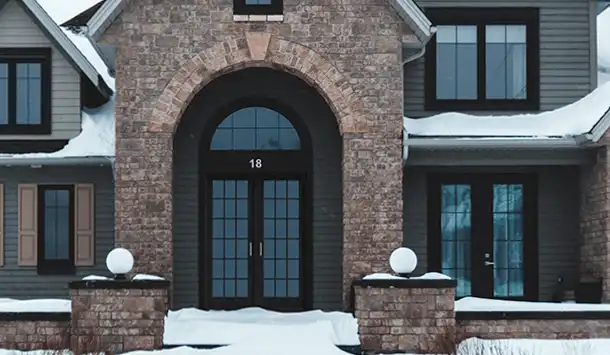
When deciding French doors vs sliding doors, one similarity French doors have with sliding doors is that they can be made from wood, vinyl, or aluminum and are available in many styles, including traditional and contemporary. They usually have an inset window between the two sets of doors. The inset window allows natural light to come through while still offering privacy to passersby outside your home.
Types of French Doors
French doors are available in different types, styles, and sizes. There are six basic french doors: single in-swinging, double in-swinging, doubles that swing out, center-hinged in-swinging, single slider, and telescoping slider.
1.Single In-Swinging:
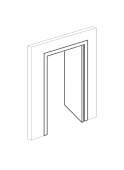
This type of door swings inward and can be used as both an entrance and an exit. It is often used as a bathroom door or patio door.
2.Double In-Swinging:
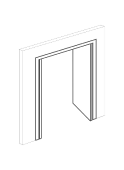
This type of door opens inward but has two separate panels that slide together when closed. They are usually installed on smaller doors where space may be limited.
3.Doubles That Swing Out:
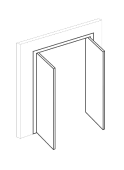
These doors are similar to those that open inward with one exception: they open outward instead of inward. The panels slide together when the door is closed and make a continuous panel at the top and bottom edges.
4.Center-Hinged In-Swinging:
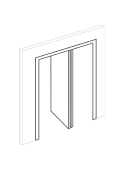
This type of door swings inward and is hinged in the center. It is commonly used in kitchens or bathrooms because they take up less floor space.
5.Single Slider:
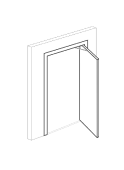
These types of french doors slide horizontally across an opening like a sliding glass door. They offer ease of use and are often used in apartments, condos, and condominiums where space is limited.
6.Telescoping Slider:
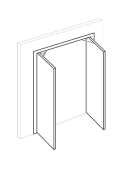
This type of door has two separate panels that slide together when closed. It is similar to a double sliding door except that both panels retract inside the frame when open instead of outside as a standard slider door does.
How to Install French Doors?
Installing French doors is a big project, but it is also doable. Here are some tips to help you install French doors in your home:
Step 1: Measure the Opening
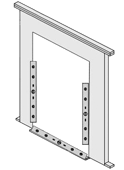
Before you start shopping for your doors, measuring the opening where they will go is essential. This ensures that you get the right door size for your space and gives you an idea of what kind of price range to expect when shopping for new doors. It also helps if you have an idea of what style you want before going shopping so that you can find a door to fit your needs and budget.
Step 2: Install the Door Jambs
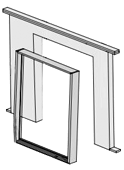
If there are no door jambs already installed in your opening, then you will need to install these before installing the doors themselves. These pieces help support the weight of the doors and add stability to prevent them from falling out or moving around too much once installed. You can find pre-made ones at most home improvement stores or make them yourself using lumber and brackets, though this may require hiring a contractor.
Step 3: Install the Doors
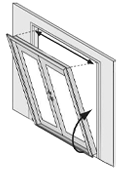
Once the door jambs are set, you can now install your French doors by inserting them into their respective openings and securing them into place with screws or bolts. Be sure not to over-tighten these as this could cause damage to your door frame or glass panes.
What Are Sliding Doors?
Sliding doors are a type of door that slides back and forth on a track. They are the perfect choice for spaces where you want to make the most of your view, but they are also great for rooms that do not have much space. When deciding french doors vs sliding doors, you will know that sliding doors are also available in various styles and colors to suit any taste.

In addition to being easy to operate, sliding doors can be installed in any room without obstructing traffic flow through the house. And because they do not swing out into the room or block access to other areas, they offer the flexibility of being able to be opened from either side without damaging them or cluttering up space inside your home.
Types of Sliding Doors
1.Bi-folding Doors:
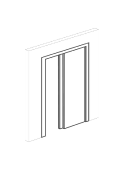
These sliding doors can be used as entrances, exits, or as room dividers. They consist of two panels that fold like accordions into a single panel. They are often found in commercial spaces such as stores and banks, but they can also be used in residential spaces like dining rooms and living rooms.
2.Sliding Patio Doors:
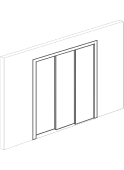
Sliding patio doors use the same basic principle as traditional sliding glass doors, but they have an additional frame and track system to provide greater security and stability. This is especially important if a sliding patio door is exposed to weather conditions, such as rain or snow.
3.Pocket Sliding Doors:
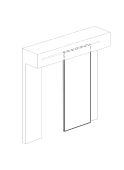
These doors are easily recognized by their unique design, which includes a pocket-like space between two panels that slide open and closed. Pocket doors are typically found in closets, kitchens, and bathrooms.
4.Stacker Sliding Doors:
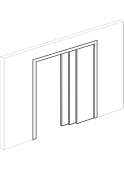
Stacker sliding doors have two panels that slide on tracks. These tracks typically have a center rail that runs along each panel's top and bottom. Each panel is attached to this center rail with a pin that slides into place when the door is open and locks into place when it is closed.
5.Bypass Sliding Doors:
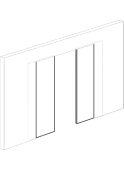
These are one of the most popular types of sliding doors. They feature two panels that slide past each other on a track or rail system at the top and bottom of the door frame. Bypass sliding doors are typically used for patios, porches, and other outdoor areas, but they can also be used to create an indoor room divider or separate rooms in a house.
How to Install Sliding Doors?
Installing sliding doors is not a difficult task. If you have the right tools and materials, you can install a sliding door in a few hours.
Step 1: Install the Track
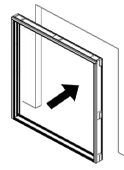
The first step is to install the track on the floor. Use wood screws or nails to secure it in place. If you are using lumber as your base material for installing sliding doors, then use pocket screws or other fasteners designed for this purpose.
Step 2: Install Jamb Extensions

The next step is to install jamb extensions if necessary. This is done by cutting off the excess material from one side of your doorframe so that there is enough room for your door frame to fit into it when closed. Then, attach these pieces back onto your door frame with screws or nails, ensuring that they do securely into place before installing the actual door itself.
Step 3: Install the Door
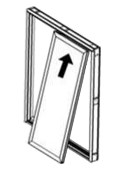
Once you have installed your jamb extensions, the next step is to install the actual door. This involves ensuring that it fits securely and that there are no gaps or spaces between either side of the frame and the door itself. It also means making sure that there are no gaps between each of your hinges or handles and ensuring that they are all aligned correctly before attaching them to their respective spots with screws.
French doors vs Sliding Doors: Cost
French:
Pros— Traditional French doors are a great way to get the look of traditional French doors without the cost.
Cons— French doors are often custom-made, so because of that, the cost can vary considerably depending on the type of door, the size and the style you choose.
Sliding:
Pros— Sliding glass doors are usually less expensive than hinged or swinging doors.
Cons— Simple sliding doors are less expensive than other types of sliding doors, but they can be more expensive than other types of doors including bi-fold and tri-fold doors.
French Doors vs Sliding Doors: Security
French:
Pros— The French doors typically have a higher level of security than other doors. This is because they are usually made with double-pane glass, which makes it difficult for burglars to break into the house.
Cons— French door locks sometimes fail to lock properly, leaving your home vulnerable to theft or vandalism.
Sliding:
Pros— Sliding doors provide privacy and security for rooms that need to be closed off from the rest of the house. They can also be used to divide rooms without having to cut holes through walls or ceilings.
Cons— While some sliding doors come with built-in blinds or curtains, they do not offer the same privacy as hinged doors.
French Doors vs Sliding Doors: Space
French:
Pros— French doors are great at adding more space to a room without having to build or remodel your current space. They can even help you increase the value of your house by adding square footage.
Cons— The biggest downside to French doors is that they take up quite a few space spaces like washrooms or storage.
Sliding:
Pros— Sliding doors are the perfect way to add a sleek, modern touch to any room. Their sleek design is both stylish and practical, allowing for easy movement of furniture or other objects.
Cons— While sliding doors take less space, they are generally larger than other types of doors, so they will take up more space in your room or hallway.
French Doors vs Sliding Doors: Security
French:
Pros— You can use french doors to balance privacy with openness in any room by choosing an open-style design that allows you to see through into another room while still keeping things private if desired.
Cons— French design doors are typically made of aluminium with glass panels on both sides of the door. This makes them very heavy and difficult to move around when needed.
Sliding:
Pros— Sliding doors are easy to open and close, and they can be installed on the interior or exterior of a home.
Cons— When the frame is not square, it will cause your door to bind or stick when it slides open or closed.
French Doors vs Sliding Doors: Energy Efficiency
French:
Pros— French door insulation will help prevent drafts, making your home quieter.
Cons— The insulating capabilities of these types of doors vary depending on where they were manufactured and how thick the glass is.
Sliding:
Pros— Squeaky sounds can be very annoying when trying to walk through a room where there is a squeaky door, but sliding doors do not make any noise at all when opening or closing them.
Cons— If sliding doors are located on the exterior portion of your home with less insulation, they will not be as energy efficient as interior doors.
III. Single Pane or Double Pane: What Are the Differences?
1. Cost
Single pane windows cost relatively less as compared to double pane windows. The overall construction and materials used make for simpler production that eventually lowers the cost. Moreover, with double pane windows, there are additional costs like glazing and specific installation. Also, if the window breaks during installation, you have to pay for replacement rather than repair, like on single pane windows.
2. Appearance
Single pane vs double pane windows are available in identical styles. Aesthetically, it is hard to tell the difference between them. However, since single pane windows are going out of use quite rapidly, there are more designs available and manufacturers are innovating with newer ways of making these windows more interesting.
3. Quality
Depending on the manufacturer, both single and double pane windows are available in high-quality finishes. Double pane windows offer more benefits so they deliver greater value for money which makes them superior in this perspective. Overall quality for both remains identical when purchasing from a trusted manufacturer.
4. Insulation
This one remains undisputed. Double pane windows are made up of two sheets of glass which provide far greater insulation as compared to single pane windows. Furthermore, the two sheets of glass hold a small air pocket between them which provides additional temperature shielding for the home or office where they are installed. These factors allow double pane types to excel in insulation comparison of single pane vs double pane windows.
5. Energy Efficiency
Double hung windows provide greater energy efficiency for homes. Their insulation capabilities allow HVAC systems within homes to function more effectively. Double pane windows provide strong barriers for heat to leave the house or cool air to enter, offering greater benefits in terms of energy conservation.
6. Thermal efficiency
Once again, double pane windows take the prize here. Their construction allows a strong barrier between the outside atmosphere and the internal temperature. When it is cold outside, your home can stay warm and vice versa thanks to double pane windows. Single pane windows don’t provide the same level of comfort.
7. Installation
The installation of double and single pane windows is similar. They are manufactured in identical frames and can be installed by the same professional. However, handling is a crucial concern because a slight mishap can be more costly with double pane windows.
The installation of double and single pane windows is similar. They are manufactured in identical frames and can be installed by the same professional. However, handling is a crucial concern because a slight mishap can be more costly with double pane windows.
8. Maintenance & Cleaning
Both double and single pane windows are easy to maintain and clean. Essentially, they are still panes of glass which means that a squeegee and glint are enough to keep these windows looking fresh and beautiful.
IV. Conclusion
Having to choose between single pane vs double pane windows is quite common in modern construction. However, the many benefits that double pane windows have over single pane windows make them a preferable choice for both contractors and homeowners. Double pane windows are expensive but they provide more in terms of value to customers. This allows more people to gravitate towards them when building a home. Contemporary designers are now even installing triple pane windows which have even more benefits but are naturally more expensive.
